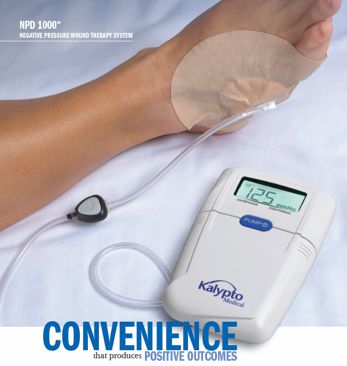

They reported that 296 of the wounds responded favourably stating that the technique led to the removal of chronic oedema, increased blood flow and increased granulation tissue.
#Negative pressure wound therapy skin#
They subjected 300 wounds of varying chronicity to their ‘vacuum-assisted closure’ technique until the wounds were either completely closed or covered by a split thickness skin graft or local flap. and forms the basis of todays contemporary dressings. The use of an open pore polyurethane dressing exposed to a subatmospheric pressure (125 mmHg below ambient pressure) was promoted by Argenta et al. Most of the devices currently on the market contain a similar open pore polyurethane dressing. They noted that such a method had a positive effect on granulation tissue in the management of open fractures. In 1993, Fleischmann et al, described a more familiar version of NPWT using a polyurethane sponge. As their system required fewer dressing changes compared to traditional methods they concluded it would be more cost-effective in the long-term. They believed that their system was effective in promoting fluid drainage, helping the formation of granulation tissue and reducing skin damage. The system they described was different to today’s devices as it used a gauze-filled dressing connected to walled suction at pressures of 60-80 mmHg. who described a nascent suction drainage system for the management of incisional and cutaneous fistulae. NPWT was first promoted in 1989 by Charker et al. A particular emphasis has been placed on the evidence supporting its use and its overall cost-effectiveness.

This review of the evidence based principles aims to review the extent to which NPWT has contributed to improvements in the management of wounds in the trauma and orthopaedic setting. Evidently improvements in wound healing, while offering health benefits to the patient, would offer significant financial incentives to healthcare providers. In the USA the market of advanced wound care is worth about $4.4 billion and is expected to continue to rise. Injuries and wounds, especially when open, put a significant strain on both the patient and clinician alike. There is a definite need for safe and effective wound management treatments. Identifying the effect of NPWT amidst so many potential confounding factors is not without its difficulties. Contributing to this is the fact that wound healing is a complex process affected by both local and systemic factors. Despite this growing popularity there is a paucity of evidence behind its use. Whilst cotton gauze is an inexpensive product which is able to keep wounds clean and covered whilst absorbing exudate, many clinicians feel that NPWT is a more dynamic alternative that reduces infection and promotes early closure. NPWT is commonly used in place of more traditional dressing techniques using cotton gauze. Its use in orthopedics is diverse and includes the acute traumatic setting as well as chronic troublesome wounds associated with pressure sores and diabetic foot surgery. Its use is widespread amongst surgical specialties many of which employ NPWT to varying degrees as part of their armamentarium against challenging wounds. Negative pressure wound therapy (NPWT) is a popular treatment for the management of both acute and chronic wounds.


 0 kommentar(er)
0 kommentar(er)
